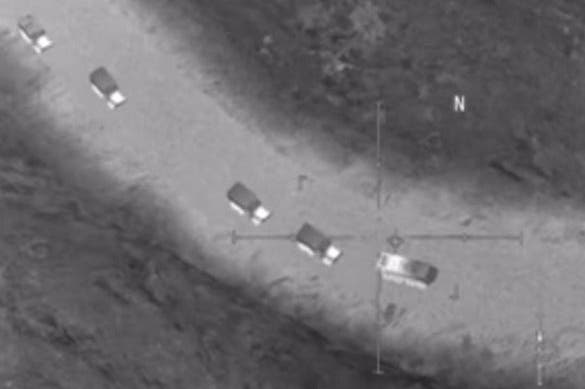Russia uses game screenshot to try and claim US is working with ISIS
Tanks, but no tanks.
The Russian Ministry of Defence has released an image it claimed showed US forces covering the retreat of so-called Islamic State fighters. Proof, it said, of collaboration between the two sides.
The only problem? The image is actually from a video game named AC-130 Gunship Simulator. Specifically, the image comes from gameplay footage uploaded to YouTube by its little-known developer (thanks, PCGamesN).
Journalist Eliot Higgins was first to notice the Russian MOD's Twitter post as fake news:
According to Eliot, the image was captioned: "ISIS automobile convoy leaves Abu Kamal for Syrian-Iraqi border (November 9th, 2017)". It was part of a series of images, others of which were photos, which Eliot stated were designed to falsely link the US and so-called ISIS forces.
The Russian MOD's tweet follows last night's statement on Russia from British prime minister Theresa May, who accused Vladimir Putin's government of attempting to "undermine free societies" - specifically, by influencing elections such as last year's Brexit referendum. Russian politicians have since reacted with irritability, and dismissed May's claim.
AI News journalist Laura Rozen suggested the Russian government's mood - and its statements about the US' ties to ISIS today - were related.
Ironically, May's speech had accused Moscow of "planting fake stories" to "sow discord in the West", BBC News reported.
The Russian MOD's tweet has now been deleted - although not before other Russian channels reported on the claim as news:
It's not the first time Russia has been spotted using video game imagery in error. Three years ago, in perhaps less serious circumstances, the Russian government-funded RT broadcast a screenshot from Metal Gear Solid 5: The Phantom Pain in a political report on African soldiers.
That's not to say other countries haven't slipped up, too. Back in 2013, a Danish channel apologised for showing an Assassin's Creed screenshot during a news report on Syria.
And, here in the UK, ITV confused a video clip of Arma 2 for real-life footage of a Libya-funded IRA attack, while BBC News used a Halo UNSC logo when referring to the UN Security Council.
The difference with the above reports, however, is there's no suggestion those mistakes were anything other than human error. Save for RT, all of the media outlets swiftly acknowledged their slip-ups and apologised.


